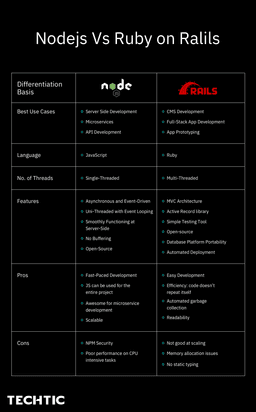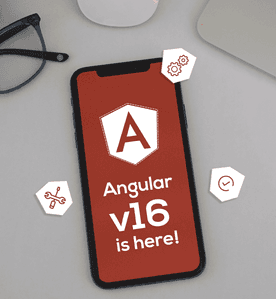A Detailed Discussion on Node.js vs. Ruby on Rails – 2022
Sector: Technology
Author: Nisarg Mehta
Date Published: 08/05/2022

Contents
Prior to working on a new project, the software development team deliberates extensively to decide on the best language, framework, or method.
We know that different technologies have different advantages and disadvantages and that one technology that looks promising for one project may be inadequate for another. Therefore, proclaiming one technology worthless would not be appropriate.
However, choosing a front-end technology for your website is fairly simple—CSS, HTML5, and JavaScript are the obvious choices. But, choosing a backend technology is a lot more difficult.
Node.js and Ruby on Rails have recently become the most popular backend languages. Each has its advantages and limitations, and we’ll discuss every aspect of them in this article. So stay with us till the end.
Overview of Node.js
Node.js is an open-source, cross-platform server-side JavaScript environment (Framework). It is built on Google’s V8 JavaScript engine (written in C++), which allows JavaScript to be executed outside the web browser.
In 2009, Ryan Dahl developed node.js, which allows SDEs to write command-line JavaScript tools and deep, scalable network applications (server-side scripting—running scripts server-side—to generate dynamic web page content before the page is sent to the user’s browser).
Node.js enables developers to create real-time dynamic web applications that work on virtually any platform (Linux, Microsoft Windows, and Mac OS X, for example).
It is equipped with helpful JavaScript libraries. SDEs may create large-scaled servers without using threading by using event-driven programming in Node.js. Callbacks signal when a task is complete, and with event-driven programming, threads are not required.
Where is Node.js Suitable?
Let’s understand how the features and advantages of Node.js come in handy while developing back-ends.
Server-Side Development
Using Node.js, applications can handle multiple requests at once, thanks to its long-polling method that establishes robust communication between the server and the browser. Instead of waiting for all queries to be processed, Node.js starts working on new requests right away.
Node.js is well-suited to real-time apps, such as messengers, online games, real-time collaboration platforms, chat rooms, etc. Using JavaScript on both the frontend and the backend will make development quicker and more straightforward.
Moreover, if you have previously worked with JavaScript, learning Node.js for the backend will be straightforward.
Microservices
Node.js’ non-blocking request processing algorithms and event-driven approach are a perfect fit for microservices.
As you can process hundreds of internal requests at the same time using non-blocking request processing algorithms and an event-driven approach, the structure of microservices is ideal. Because microservices must communicate constantly, quick data processing is critical.
Microservice architecture and Node.js both care about speed and effectiveness. Microservices allow developers to construct efficient, high-performance platforms by dividing functionality into small services. The V8 engine in Node.js, combined with non-blocking processing, helps accomplish this goal.
Application Programming Interfaces
Node.js is a popular choice for building REST APIs. The Representational State Transfer—REST is the architecture that enables clients to receive answers to their web requests quickly.
The standard principles of REST development are uniformity, statelessness, client-server communication, layered architecture, cacheability, and on-demand responses.
Web apps rely on REST APIs to deliver source results to users. Whenever a user is looking for something, the user’s input is connected to the software’s code through a REST API connection.
Because it is fast at processing requests and uses JavaScript technology, Node.js is an obvious choice for developing REST APIs.
Popular Apps Built Using Node.js
Due to its performance and responsiveness, many big players in the market use Node.js including Amazon, Netflix, Uber, LinkedIn, eBay, Reddit, Tumblr, and PayPal.
For instance, Netflix decentralized its web platform and used Node.js as the main backend tool in the process. This led to the app’s bigger scalability and responsiveness.
Netflix decentralized its OTT platform by using Node.js as the prominent backend technology. This allowed Netflix to scale its web platform and improve its responsiveness.
Similarly, PayPal used Node.js for prototyping as well as development. The company reports an unprecedented increase in the application’s performance and development efficiency due to Node.js.
Overview of Ruby on Rails
Ruby on Rails is a server-side web app framework that’s written in the Ruby language and accredited by MIT university. David Heinemeier Hansson, who serves as its guide, created it.
Rails is the MVC framework and a software library that provides the default structure for databases, web services, and web pages. It also encourages the use of web standards like JSON or XML for data transfer and HTML, CSS, and JavaScript for an attractive user interface.
Ruby on Rails is a superb choice for developing database-backed web applications since it simplifies their management.
Besides MVC (Model-View-Controller), Ruby on Rails utilizes other common software engineering patterns and philosophies, like Convention over configuration (CoC), Don’t repeat yourself (DRY), and the active record pattern.
Where is Ruby on Rails Suitable?
Ruby on Rails is an efficient and reliable backend framework for web applications. In contrast to Java or Node.js, you can create sophisticated functionality with less code using Ruby on Rails.
Following are the best use cases of Ruby on Rails:
CMS Development
Although Ruby on Rails is still not the leading option for developing content management systems and developers are still using PHP, Ruby on Rails has recently entered the market, and it provides a lot of advantages.
Because Ruby on Rails has high abstraction levels, it is easy to construct rich functionality. You can map tables and databases as distinct objects, for example. You may refer to a large number of capabilities with just a few lines of code.
Full-Stack Web App Development
The Rails framework follows a set of strict rules about how to structure your code and utilize the Model, View, Controller framework.
To develop an app using Ruby on Rails, you must define a view, controller, and route. It is true that getting started with an MVC framework is time-consuming, but in the long run, it’s efficient, and the code is well-organized and simple to read. You will end up with an organized and easy-to-maintain code.
App Prototyping
Using Ruby on Rails, you can develop a minimally viable version of your product quickly and efficiently, thanks to its built-in features and open-source libraries.
The emphasis when developing a minimally viable product is on operation efficiency and well-managed development processes rather than ultimate speed and interface.
Developers can avoid writing code from scratch using a command-line code builder, saving time and effort. Moreover, with open-source libraries, this ready-to-use code can include more than half of the functionality.
Popular Apps Built Using Ruby on Rails
Many popular platforms like Github, Airbnb, Basecamp, Bloomberg, and SlideShare have been built using Ruby on Rails.
For instance, the project management tool, Basecamp, reports that they spend only 15% of its budget on Ruby on Rails. This speaks about the cost efficiency of this technology.
Whereas SlideShare states that with Ruby on Rails, they’re able to scale to 3 million unique visitors during their initial years.
Node.js vs. Ruby on Rails - One on One
Now, when you’re familiar with both platforms, it’s time to discuss Node.js vs. Ruby on Rails one-on-one.
Both these technologies are quite similar in terms of ease of testing, microservice compatibility, database support, community, and resource availability. But there are noticeable differences in terms of performance and scalability.
Let’s discuss.
Node.Js is the Winner in Terms of Performance
Because Node.js is composed of the asynchronous and non-blocking characteristics of JavaScript, it is well-suited for completing small tasks (micro-tasks) independently without impacting the main application thread. V8’s Javascript engine allows for more efficient multitasking, resulting in lightning-fast performance.
Many tech giants are turning to Node.js for its performance, and for one thing, Paypal saw a 35% drop in the average response time and doubled the requests per second. Another example is Linkedin, which migrated to Node.js and eliminated its servers from 30 to 3.
On the other hand, Ruby on Rails is not the most efficient or quickest framework around. In certain situations, Ruby’s garbage collection, which is an interpreted software, can slow down the application. However, such situations are very uncommon, especially when traffic is high.
Node.js Excels in Terms of Scalability
Node.js programs are able to handle numerous simultaneous requests because of the non-blocking I/O and event-driven design. Additionally, the event-loop mechanism enables the server to process the greatest number of requests. Furthermore, Node.js has the greatest compatibility with microservices by dividing applications into smaller components. As a result, it is efficient to divide tasks among several development teams and develop applications faster and more scalably.
Whereas Ruby on Rails can be scaled, it requires more resources than some of the other major backend frameworks. When Twitter switched from Rails, a lot of people wondered about its scalability. Despite this, Shopify and Airbnb are sufficient to demonstrate Rails’ capability to handle higher traffic. Still, memory management and Ruby’s poor concurrency cause problems when trying to scale rapidly on the platform.
Node.js vs. Ruby on Rails - At a Glance

Node.js Vs. Ruby on Rails - Which one is Right for You?
Node.js and Ruby are both excellent for backend development, but neither one is perfect.
Node.js is appealing because it allows JavaScript to be used for the entire technical stack and for high-performance processing speed.
Whereas due to its straightforward syntax, Ruby on Rails is well known for its excellent design. Developers don’t have to reiterate themselves or use needless statements in order to create high-quality code. Performance isn’t a strong suit for the language itself, but the development process is one of the most efficient available.
If you still feel confused about making a decision, feel free to get in touch with us. We’ll be happy to help you design your entire application architecture.
Latest Tech Insights!
Join our newsletter for the latest updates, tips, and trends.




